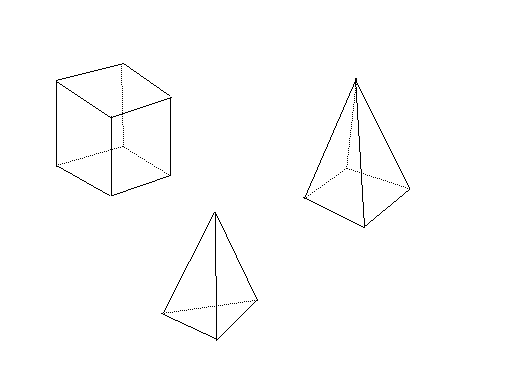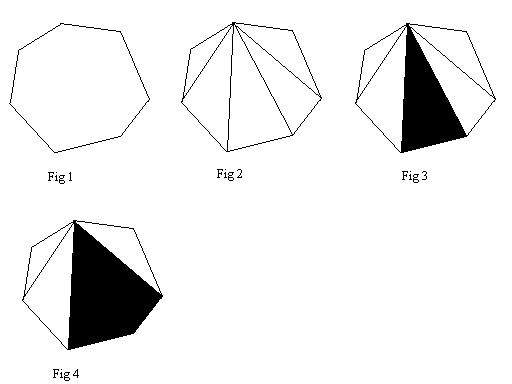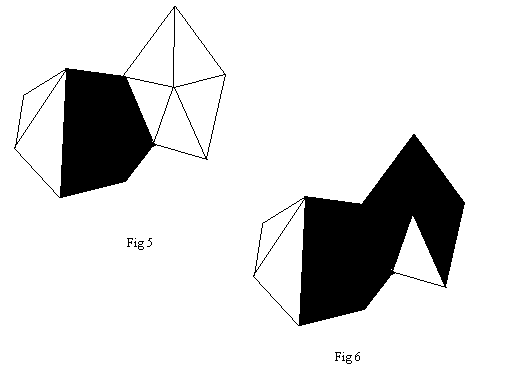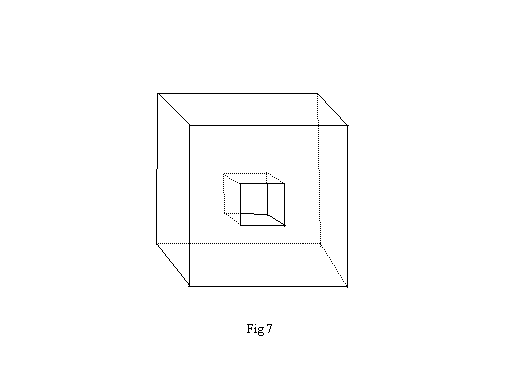
I am hardly a mathematician, but I have always been fascinated by how mathematics is discovered and how it relates to other aspects of human thought. The philosopher Imre Lakatos used a theorem named after Euler to illustrate how mathematical discoveries may be made, proved, criticised and developed. I give my own version here.
| Imagine some solid figures like the ones shown on the right, a cube, a tetrahedron and a pyramid on a square base, or at least that is what they are if you use your imagination on my poor drawings. | 
|
Now if we count up faces, edges and vertices for those figures, we find that the cube has F=6, E=12 and V=8. The tetrahedron has F=4, E=6 and V=4. As for the pyramid, F=5, E=8 and V=5. In the latter case, we can easily see that if you build a pyramid on an n-sided base, you will end up with a figure of n+1 faces, 2n edges and n+1 vertices. In every case, F-E+V=2. Is this always so, no matter how complicated the shape? How could we ever find out?
| Well, imagine some solid shape with all kinds of sides. It must have some number of faces, F, some number of edges, E, and some number of vertices V. F-E+V must equal something, call it x. The whole thing is too vague to picture - let's think about just one face. | 
|
If that face is not itself a triangle, we can pick one vertex of it, and draw lines from that vertex to others so as to divide the whole face into triangles. There is an example in Figure 1. In Fig 2, lines have been drawn from one vertex to form triangles. The new triangles can be thought of as faces, too, even though they are in the same plane as a neighbouring triangular face. There is no reason why there should be a "bend" at every edge of a solid figure. Notice that each new triangle is produced just by drawing one new line across a face. Every time such a line is drawn, the figure gains one new face and one new edge, that is, F and E both increase by one, so F-E and hence F-E+V stay exactly the same.
The next step is to "snip out" one of the triangular faces of the solid, as shown in Fig 3. A face is removed, but the number of edges and vertices stays the same - they are now edges and vertices of a "hole". F is reduced by one, while E and V stay the same, so that F-E+V becomes x-1. Next we snip out an adjacent triangular face, as shown in Fig 4. The effect of this is to remove one more face, and also one edge. F-E+V remains the same!
In that case, we can just continue snipping out the triangles, leaving F-E+V the same for each new figure. In the end, we will be left with just one triangle, and for that, F-E+V is still x-1! Obviously now F=1, E=3 and V=3. F-E+V=1, so x=2, just as we thought it would be! But now this has actually been proved - an argument has been set out which does not depend on any particular solid figure, but which could apply to any of them. Marvellous!
 |
But wait! Does the triangle snipping necessarily continue as in Fig 4? Look at Fig 5. As we carry on snipping from there, we may end up in the position shown in Fig 6. |
When that last white triangle is snipped, not just one face and one edge will disappear, but one face, two edges and one vertex. F is reduced by one, but E by two, so F-E will increase by one. V is reduced by one, so altogether F-E+V still remains the same! The theorem is saved!
| What about more complex solids like the one in Fig 7? |  |
This is a cube with a hole in it. It still has the the original six faces of a cube, plus four more inside the hole. So F=10, altogether. The original cube had 12 edges, and the hole has 12 edges too, making E=24. The hole has 8 vertices as well, just like the original cube, so V=16. F-E+V = 10 - 24 + 16 = 2! Euler's theorem still works, even for such a greatly different shape. But what about the proof of it worked out before? That depends on dividing up each face into triangles, but we can't always do that when the hole is there. It prevents us drawing a diagonal across a face to divide it into two triangles. Even though the theorem works, the proof of it needs improvement.
And then suppose the hole does not go all the way through the cube. That makes it a sort of well, with an extra face at the bottom. Now there are 11 faces, but still the same number of edges and vertices, so F-E+V is 3, and not 2. It would be quite a task to work out just what kinds of solids the theorem applies to, and to work out a proof that remains valid in every case.
As Lakatos pointed out, there are conjectures and refutations in the purest mathematics too.